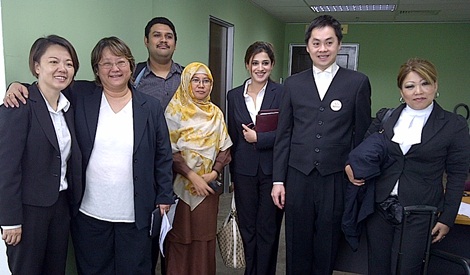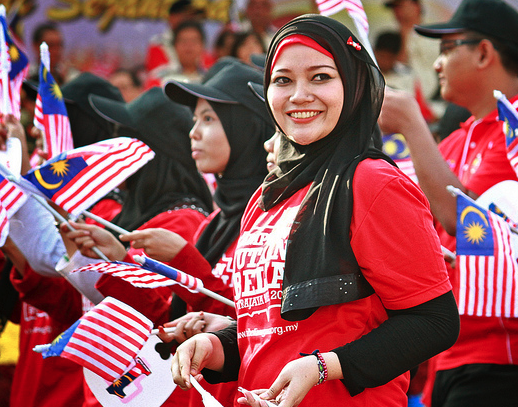A critical analysis of the case of the pregnant teacher who sued the government for gender discrimination, and what Malaysia must still do to ensure it meets its international obligations.
The decision of the High Court (Shah Alam) in the case of Noorfadilla bt Ahmad Saikin v Chayed bin Basirun & Ors [2012] 1 MLJ 832, HC gave a boost to women’s rights in Malaysia, and injected a much needed breath of fresh air, more broadly, to human rights in the country. [LB: An appeal by the Government against the decision was subsequently withdrawn.]
The decision situates women’s rights squarely in the domain of human rights. Further, in opining that it is the Courts’ role to “promote the observance of human rights”, the decision helps further strengthen the role of the judiciary as the ultimate safeguard to individuals’ fundamental rights enshrined in the Constitution. Significantly, notwithstanding the absence of an enabling statute incorporating the 1979 Convention on the Discrimination of All Forms of Discrimination Against Women (CEDAW) into domestic law, the Court had no hesitation to apply the relevant law in the Constitution on the basis that the Constitutional amendment incorporating the word “gender” in Art. 8(2) was made in order to comply with Malaysia’s obligation under the treaty.
The Court went to some length on this point, referring even to Parliament’s Hansard. This may well be the first time a Malaysian court applied international law to interpret a provision in the Constitution in such a direct manner, as opposed to a subordinate legislation. In wielding the authority of the Court to use an international binding treaty for the interpretation of the relevant provision in the Constitution, the Court reached a protective outcome for an individual, as well as help Malaysia fulfil its obligations under international law. In this way, the Court has put the rule of law, national and international, and supremacy of the Constitution on ever firmer footing.
The Court’s innovative approach is praise-worthy, particularly in view of a number of fairly negative earlier court decisions on the issue of pregnancy as a form of gender discrimination against women. There are significant arguments which could have defeated the plaintiff’s claim of gender discrimination. Firstly, on the face of it, the authorities’ refusal to hire the plaintiff was not on the basis of the plaintiff being a woman; rather it was due to her pregnancy, which per se, is not a protected characteristic. Secondly, the concept of “reasonable classification” or “intelligible differentia” continues to lurk and was in fact raised by the defendant. Putting the two together, it might have been argued that there was no discrimination against the plaintiff in relation to other women who are also pregnant, as all pregnant women would not have been hired.
However, this is clearly against the underlying rationale for women’s right to non-discrimination. The Court used Art.1 in CEDAW to interpret the meaning of “gender” in Art. 8(2) of the Constitution. This clarified in no uncertain terms that the conceptual dimensions of this Constitutional term concern the non-discrimination of women against men, so as to enable women’s rights to be recognized and enjoyed or exercised “on the basis of equality of men and women”. Since this is the rationale, then, clearly “gender” in relation to Art.8 (2) is not susceptible to the concept of “reasonable classification”.
There are indeed, and rightly so, Court decisions to the effect that broadly, Art. 8(2) is not subject to the concept of “reasonable classification” as opposed to Art. 8(1) relating to equality before the law. These decisions were cited by the High Court in this case. Drawing from the High Court’s decision, and pending legislation to provide a definition of “gender discrimination”, it may be argued that all claims by women based on ‘gender discrimination” should be understood as set forth in Art. 1 of CEDAW. It is only fair that women be not disadvantaged against men because of women’s biological traits. In particular, as regards pregnancy, husbands, families and communities also benefit from child bearing. Employers will be put to pains, but as in this case, on a balance between institutional convenience and individual fairness, fairness should come out ahead.
The decision has been lauded by a broad spectrum of civil society. Clearly the judiciary has a key role to play in defending women’s rights in the country. Yet, it is important to highlight the part played by the Executive arm of government, without which the advancement of women’s rights in the country could be an overwhelmingly daunting task. It may be noted from the decision that not only did the Court refer to CEDAW, but also to international meetings attended by the Government as demonstrative of the latter’s “commitment” to CEDAW.
Indeed, as early as the mid 1970’s, coinciding with the time when CEDAW was on the way to being adopted by the United Nations, but well before acceding to it, focus was already given by the Executive to women’s role in development, and a number of government entities were established for this purpose, such as the National Advisory Council on the Integration of Women in Development, and the Women’s Affairs Secretariat. The discourse on equal rights of women as a social group, evolved subsequently as a logical development. The various efforts culminated in the creation of the Ministry of Women, Family and Community Development in 2001, which then played a lead role to effect the amendment to Art.8(2) of the Constitution.
Encouragingly, recent statements of Malaysian delegates to the United Nations General Assembly as well as to the Commission on Status of Women reiterated the Government’s continued commitment to improving the status of women in the country. Equally important is the role played by NGOs and other advocacy groups which serve as the grass roots champions particularly with their expertise and knowledge. Their role is acknowledged and highlighted in various official statements of the Government which expressed appreciation for the support provided by these groups. What this illustrates is that ensuring the effective implementation of women’s rights is a national effort; the Executive and Civil Society need to work together while the Judiciary will serve as the ultimate defender.

Still, the Court’s decision did leave some unanswered questions. In its ruling, the Court appears to indicate that it would not have been able to intervene had there been a “policy” on not employing a pregnant woman. The Court found, as a matter of fact, that there was no such a policy and went on to rule that the act of the authorities in refusing to employ the plaintiff is in violation of Art.8 (2) of the Constitution. The question is: what if there were such a policy? Would not the Court have declared such a policy unlawful under the Constitution as much as the actual act of refusing to employ the plaintiff was?
Another issue which may warrant further clarification concerns the specification in the government circular that there is no entitlement to maternity leave. The Court used that specification to additionally support its reasoning that there is no policy bar on employing pregnant women, as otherwise, a specification on maternity leave would not be in the circular. Yet, the Court did not deal with the issue that non-entitlement to maternity leave could be a form of unlawful discrimination against women employees: Art. 11(2) (b) and Art. 5 of CEDAW would have provided support for this point. One is now left wondering how the plaintiff is going to take off from work for the delivery. Considering that maternity is not sickness, and women at work should not be disadvantaged against men to have to avail of sick leave for delivering children, the issue of entitlement to maternity leave could have been clarified, even if as “obiter”.
The inclusion of ‘gender’ as a protected characteristic in the non-discriminatory provision of Art.8(2) of the Constitution, a provision fundamentally concerning ‘equality before the law’, has put women’s rights on sound legal footing, and sent a strong political message in support of women’s rights . However, Art. 8(2) itself is limited in ambit with the proscription on gender discrimination covering only “appointment to any office or employment under a public authority”, and the “administration of law” in certain economic related sectors. There are many more areas which require legal coverage, including gender discrimination in employment in the private sector. There is no good reason why private employers should not be held to account for discriminatory practices against women which undermine the right to equal employment opportunities and equal treatment of women in the work place. Art. 11 of CEDAW, so copiously referred to by the Court, does not make any distinction between public and private employment.
Additionally, other provisions in the Constitution would also require amendments. These include notably:
- Art.12 in relation to education where the provision on non-discrimination in the field of education, should include “gender” as a ground, in line with Art.10 of CEDAW;
- Art. 13, in relation to property rights, which could benefit from a clear specification on equal rights of men and women over all matters concerning administration of property, in line with Art.15(2) of CEDAW.
- Equally important are provisions in the Constitution relating to citizenship where the scheme of right to pass on citizenship remains heavily male biased. If Art. 9 (1) of CEDAW were to be fully implemented, Malaysian women should be able to pass on their nationality to foreign husbands, in the same way Malaysian men could pass on their nationality to their foreign wives.
Apart from the above, many other areas need to be advanced, as already called for by the Bar Council and advocacy groups. Key among these is the enactment of a subordinate statute to adopt CEDAW into Malaysia’s legal system. Such a law could provide a definition of gender discrimination as stipulated in CEDAW, and set out a framework, based on CEDAW’s, where further legislative processes and other implementation action is needed. The concerned fields are vast covering legal status; political and public life; economic, civil, and social sectors, as well as marriage and family life.
Significant progress has already been made over the years. Just to name a few:-
- The conferring of equal rights of parents over guardianship of infants under the Guardianship of Infants Act 1961;
- Equal rights in the area of social security under the Employees’ Social Security Act 1969; and
- Equal rights of married couples in income taxes.
Legislative advancement needs to continue. More daunting challenges lie in the implementation of CEDAW at the practical level. A comprehensive review is provided in the Malaysian NGOs’ 2012 Alternative Report on CEDAW which makes important reading.
In as much as there is unfinished business at the national level, there is also unfinished business at the international level. Consideration should be given to lifting the remaining reservations on the specific provisions in CEDAW. In regard to Art. 9(2) of CEDAW relating to equal rights of women to pass their nationality to their children, there are no obvious reasons for not enabling Malaysian women to pass on their nationality to their children in the same way as Malaysian men could. The final frontier remains women’s rights in the area of marriage and family relations falling primarily under Art.16 of CEDAW in regard to which Malaysia has retained a number of reservations.
Admittedly, Malaysia is a country with communities steeped in religion and culture, and advancement of women’s rights in the area of family life needs to be undertaken bearing in mind sensitivities. Yet, if women’s’ equal rights with men are to be truly meaningful, the Executive arm of Government needs to make bold moves in sync with a changing environment to modernize, and ensure that women’s potential is maximized in family life just as in all other areas, for it is in the area of family relations that women are most vulnerable to subjugation and inferior treatment.

